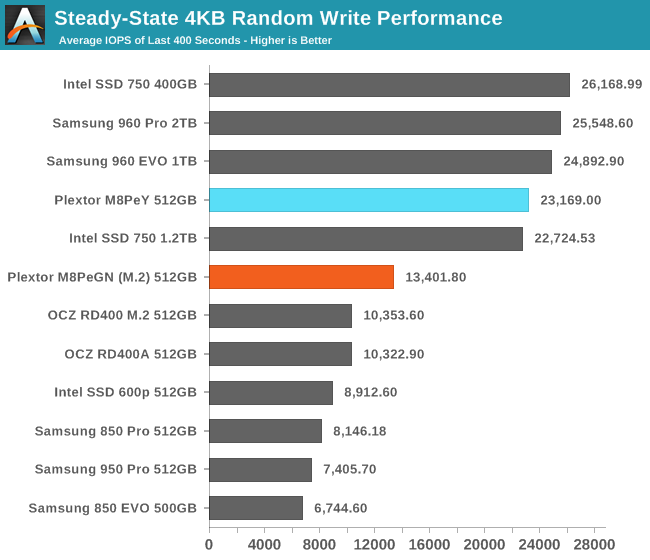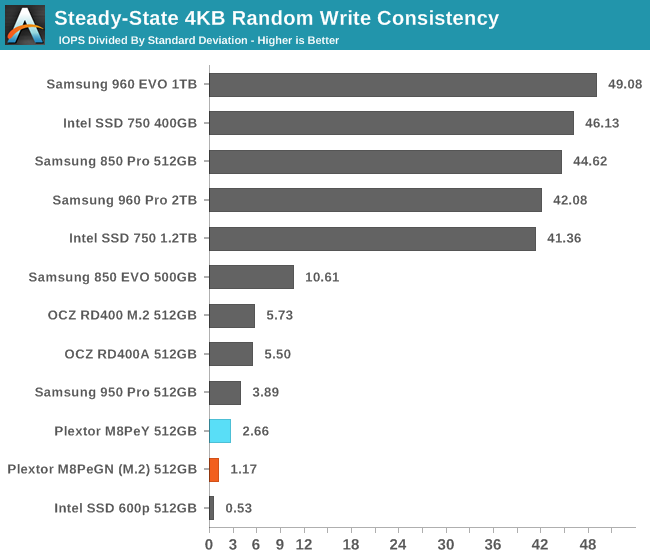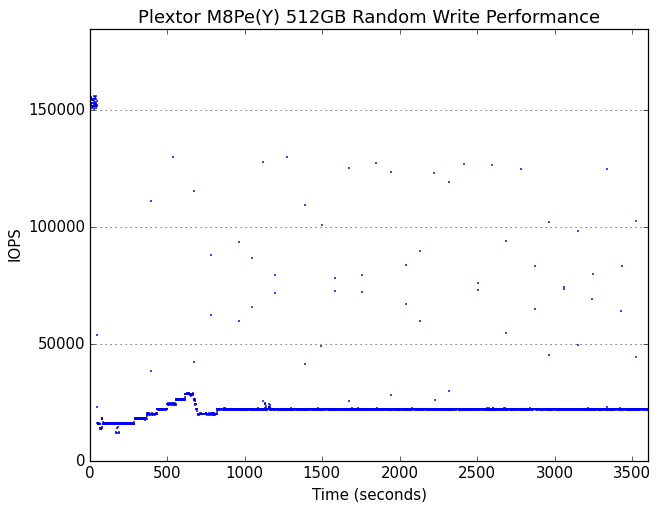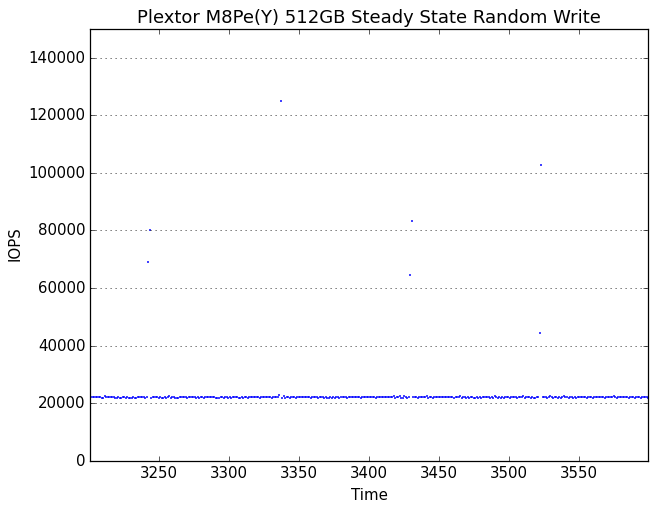The Plextor M8Pe (512GB) SSD Review
by Billy Tallis on December 14, 2016 9:00 AM ESTPerformance Consistency
Our performance consistency test explores the extent to which a drive can reliably sustain performance during a long-duration random write test. Specifications for consumer drives typically list peak performance numbers only attainable in ideal conditions. The performance in a worst-case scenario can be drastically different as over the course of a long test drives can run out of spare area, have to start performing garbage collection, and sometimes even reach power or thermal limits.
In addition to an overall decline in performance, a long test can show patterns in how performance varies on shorter timescales. Some drives will exhibit very little variance in performance from second to second, while others will show massive drops in performance during each garbage collection cycle but otherwise maintain good performance, and others show constantly wide variance. If a drive periodically slows to hard drive levels of performance, it may feel slow to use even if its overall average performance is very high.
To maximally stress the drive's controller and force it to perform garbage collection and wear leveling, this test conducts 4kB random writes with a queue depth of 32. The drive is filled before the start of the test, and the test duration is one hour. Any spare area will be exhausted early in the test and by the end of the hour even the largest drives with the most overprovisioning will have reached a steady state. We use the last 400 seconds of the test to score the drive both on steady-state average writes per second and on its performance divided by the standard deviation.

The heatsink makes a huge difference in the sustained random write performance of the M8Pe. With the heatsink, the M8Pe is competitive with the Intel 750 and the Samsung 960 Pro and EVO. Without the heatsink, the M8Pe is slower by almost 10k IOPS, but still above average for consumer SSDs, including some of the NVMe competition.

The M8Pe's consistency scores are quite low, indicating that it lacks the tight regulation of Samsung and Intel's best drives that have similar average performance.
 |
|||||||||
| Default | |||||||||
| 25% Over-Provisioning | |||||||||
The second by second performance plot reveals that the apparently low consistency is on the M8PeY due entirely to occasional outliers of extremely high performance; most of the time the M8PeY is operating at a very consistent ~22k IOPS, and none of the outliers fall below that level. The M8PeGN without a heatsink or heatspreader suffers from frequent periods of thermal throttling and slightly lower performance when not throttled. The lower performance also causes the M8PeGN to take slightly longer to reach steady state.
 |
|||||||||
| Default | |||||||||
| 25% Over-Provisioning | |||||||||
With a heatsink, the M8Pe's steady state hovers around 22k IOPS, but without the heatsink it alternates between 18k IOPS and a thermally throttled 2400 IOPS. Fortunately, it spends more time in the high-performance state than the low performance state, and there are still a few of the extreme outliers above 100k IOPS.
The M8Pe responds very well to extra overprovisioning. The variability is increased slightly, but the performance with the heatsink jumps to 90-100k IOPS sustained. Without a heatsink, the steady state only increases to 60-65k IOPS, but the drive spends much less time thermally throttled and the performance in that state increases to about 6800 IOPS. It's no surprise that the Marvell 88SS1093 controller has been a popular choice for enterprise M.2 PCIe SSDs.










64 Comments
View All Comments
close - Friday, December 16, 2016 - link
I'm not at all sure how dire the shortage is but there's plenty of online material for this. Of course, the titles might be apocalyptic but you can get a sense that it's not something to shrug off quite yet:http://www.digitimes.com/news/a20161212VL201.html
http://www.tomshardware.co.uk/ssd-hdd-shortage-nan...
https://www.custompcreview.com/news/nand-flash-pri...
https://epsnews.com/2016/10/12/supply-shortage-nan...
And this fits perfectly with the price trends for some SSDs. Crucial/Micron is a nice holdout but probably because of the in-house NAND manufacturing.
On a slightly unrelated note, while I consider Samsung's drives to deliver the highest performance (and use them because of this), I wouldn't say they are most balanced because of the price and implicitly the price/performance ratio. I still go with SanDisk and Crucial wherever top range performance isn't critical because I think they offer a lot more value.
jabber - Friday, December 16, 2016 - link
There is always a 'shortage' yet life and sales go on. Just market FUD too manipulate prices. Never seems to push through to retail much.shabby - Thursday, December 15, 2016 - link
Seems like you guys should be comparing every capacity of ssd when doing reviews, if samsung sends you only the 1tb version tell them where are the other two, because clearly they will be slower.Mr Perfect - Thursday, December 15, 2016 - link
Yes, and this could be played the other way, too. When Plextor sends in a 512GB drive, let them know that they'll be benched against a 1TB Samsung and will be at a disadvantage.Bruce427 - Friday, December 16, 2016 - link
The reason for the 1TB Samsung 960 EVO (only) is, at the time that 's all Samsung was shipping. I'm sure reviews on other models will follow soon.Billy Tallis - Thursday, December 15, 2016 - link
In the specific case of the 960 EVO, Samsung sent me a 1TB and a 250GB sample. The 250GB died, but I'm currently writing up the review of the replacement.Most of the companies and PR people I deal with are very understanding of my desire to test the full range of capacities. But for many product launches, the PR departments simply don't get enough supply to satisfy us reviewers. I can't even say that the executives several levels up who make those allocation decisions are wrong. Most of their benefit comes from the initial exposure of having the SSD reviewed at all. Providing a wider range of samples means they'll get mentioned more frequently as a point of comparison in future reviews, but that's a tough sell when it means a retailer like Newegg is more likely to run out before their second shipment comes in.
Some companies have indicated that they'd be open to providing further samples post-launch when supply is no longer constrained. But I'm not in a good position to ask for that when I still have a backlog of drives that haven't gotten a first review.
epobirs - Friday, December 16, 2016 - link
Also, don't be fooled by MSRP. I got the bare version of the Plextor for under $200 from Newegg recently. I wouldn't have been able to justify going PCIe with any other product I examined at the time.aeolist - Wednesday, December 14, 2016 - link
The 512GB M8Pe was $180 on Newegg over Black Friday, which made it a pretty easy choice for me. Keep an eye out over the holidays, I wouldn't be surprised to see it and the RD400 go on sale pretty significantly.icrf - Wednesday, December 14, 2016 - link
I did the same thing. And to clarify, it was the GN model, without the heat spreader. Aside from having a difficult time getting my Linux install copied over and booting properly, been happy with it, but haven't really stressed it yet.sinPiEqualsZero - Wednesday, December 14, 2016 - link
From a real-world perspective, are we at the point where we (meaning "the majority of humans") can tell the difference between an M.2 PCI-E and SATA drive during normal usage?I ask because I'm using a 1 GB ADATA drive that I picked up for $220 last year and it was a decent upgrade over my Crucial M4. I wonder if the jump from SATA to PCI-E is likewise noticeable.